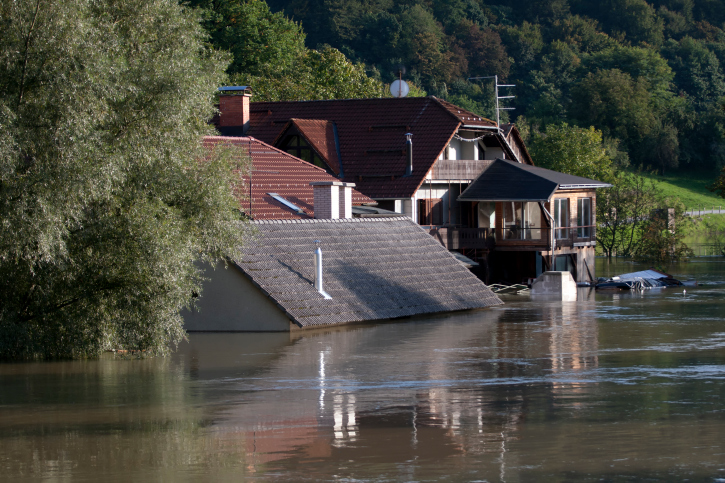The Christmas and New Year floods have caused devastation for many who are worried as to whether they can get insurance or not. Joanne Atkin looks at what government and the insurance industry are doing to protect vulnerable homeowners and what precautions can be taken.
It is estimated by the Environment Agency that more than five million properties in England and Wales are at risk of flooding. Of these, three million are at risk from surface water, 2.4 million are at the mercy of rivers or the sea and some are at risk from both. That is equivalent to one in six homes or business.
In Scotland one in 22 residential properties and one in 13 of non-residential properties are at risk of flooding, according to the Scottish Environment Protection Agency (SEPA).
 The majority of flooding is due to heavy rainfall resulting in surface water, where the drains and sewers cannot cope with the amount of water so spill over, and groundwater flooding when the ground becomes so saturated there is nowhere for it to go except above ground level.
The majority of flooding is due to heavy rainfall resulting in surface water, where the drains and sewers cannot cope with the amount of water so spill over, and groundwater flooding when the ground becomes so saturated there is nowhere for it to go except above ground level.
River and coastal flooding often take longer to drain away due to the sheer volume of water and a less frequent cause of flooding is burst dams and reservoirs.
Closer to home, other causes of flooding to a property can include a burst water tank or pipes in the home, radiator leak, or even leaving taps running.
Climate change
With the impact of climate change it is generally accepted that adverse weather, including flooding, will become more prevalent going forwards. The United Kingdom Climate Impacts Programme (UKCIP) says that during the next 30 to 80 years heavy winter rain and snow will become more frequent, the sea level will continue to rise around the UK and extreme sea levels will occur more frequently.
UKCIP concludes: “Climate change is therefore likely to increase flood risk significantly and progressively for all areas of the UK over time.”
Environment agencies
So if you are buying a property, or are even just interested in the likelihood of flooding to your current home, your first port of call is the Environment Agency and SEPA in Scotland, where you can sign up to flood alerts.
If you live in Northern Ireland there is the Department of Agriculture and Rural Development (DARD) but it does not have a flood alert service. Residents can write to their local Rivers Agency office who can inform you of any known history of flooding for your address.
These agencies all have flood maps, which give a general guide as to where the flood prone areas are situated. In December 2013 the Environment Agency published improved flood maps which showed a reduction in the number of people classed at risk of surface water flooding in England. The maps show areas of the country at risk of flooding from rivers and the sea as well as new national scale maps of surface water flooding.
Chief executive of the Environment Agency, Dr Paul Leinster, said: “We have used cutting edge technology to map areas at risk of surface water flooding in England. These maps are now amongst the most comprehensive in the world. With one in six homes in England at risk of flooding we urge people to check if they are at risk, and sign up to free river and coastal flood warnings, by visiting the Environment Agency website.”
Search providers
For more detailed information you should go to a specialist search provider. If you are in the process of buying a home, make sure your solicitor or conveyancer includes a flood search. The search report will tell you about the risk of flooding, and the types of flooding that can be expected.
Prospective buyers should also ask the vendors of the property if there has been any history of flooding.
Flood Re
Last year, the government and insurance industry put forward a proposal to tackle the problem of flood insurance particularly for those people living in flood prone areas. The scheme that the various interested parties are working on is called Flood Re. Re is short for reinsurance and is a way of spreading out the risk among a number of insurance companies.
The aim of the Flood Re scheme is to ensure that household insurance continues to be widely available and affordable in areas of flood risk without placing unsustainable costs on other policyholders or the taxpayer. The way it will work is that all insurance companies pay a regular levy into a ’pool’ and they may also have to pay extra amounts as and when needed. This pool creates a fund that can be used to pay claims for people in high-risk areas.
Initial proposals were that insurance companies will pay into the pool £180 million each year. This equates to an extra £10.50 added onto everyone’s annual household premiums but Defra (Department for Environment, Food and Rural Affairs) says this represents the estimated level of cross-subsidy that already exists between lower and higher flood risk premiums. So householders with insurance policies on properties in low flood risk areas still pay something towards the overall risk.
Exclusions to the scheme
Jeremy Blackburn, UK director of external affairs at the Royal Institution of Chartered Surveyors, believes Flood Re is a step in the right direction but he is disappointed that the Flood Re fund will only be open to those in high flood risk areas.
He explained: “It is quite possible that those living in areas that do not slot directly into this category – but are still at substantial risk – will receive minimal cover, if that. This could prove an enormous problem for those affected and is a big concern. It will also take homes out of housing supply by making it much more difficult to get a mortgage, assessed on the insurability of a property.”
Premiums for the flood risk will be calculated based on council tax banding up to a maximum limit depending on the band. However, there are exclusions. Homes in the highest council tax band H in England, and equivalent properties in Scotland, Wales and Northern Ireland will not be covered by the scheme – and neither will homes built after 1 January 2009.
Defra told the Financial Times recently that 3,800 homes in England and Wales are in Band H and are at high risk of flooding. Plus another 5,000 homes have been built in flood plains since 2009, so they will also be excluded from this insurance.
However, the majority of homes should be covered. Paul Broadhead, head of mortgage policy at the Building Societies Association, commented: ”This insurance agreement removes uncertainty for hundreds of thousands of consumers by ensuring that affordable flood insurance cover will remain available to those who live in places prone to flooding. It also banishes the spectre of mortgage issues which could have affected mobility and prices in these areas.”
Statement of Principles
Once the details of Flood Re have been finalised they will form part of the Water Bill, and will last for at least 25 years. Until the bill has passed through Parliament and Flood Re is set up, the industry will continue to use the current agreement – the Statement of Principles.
The Statement of Principles is an agreement between government and members of the Association of British Insurers (ABI), whereby insurers will renew flood insurance to existing customers, providing the flood risk is adequately managed. This agreement was set up in 2000 and was only intended to be a temporary measure.




